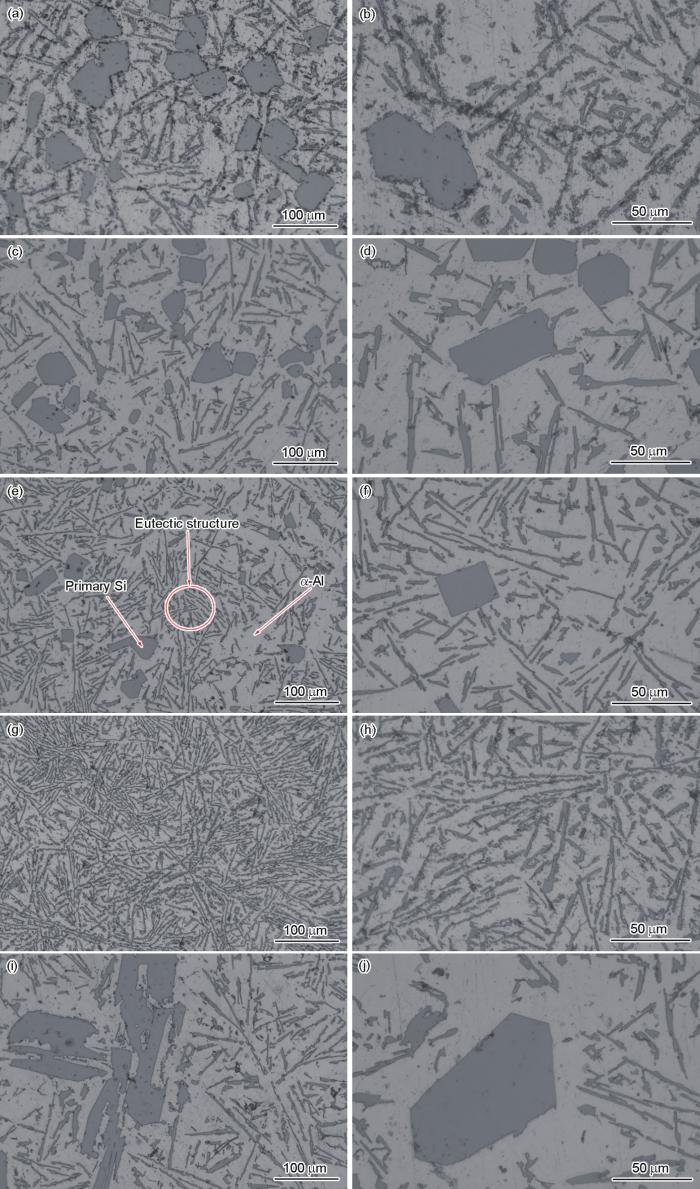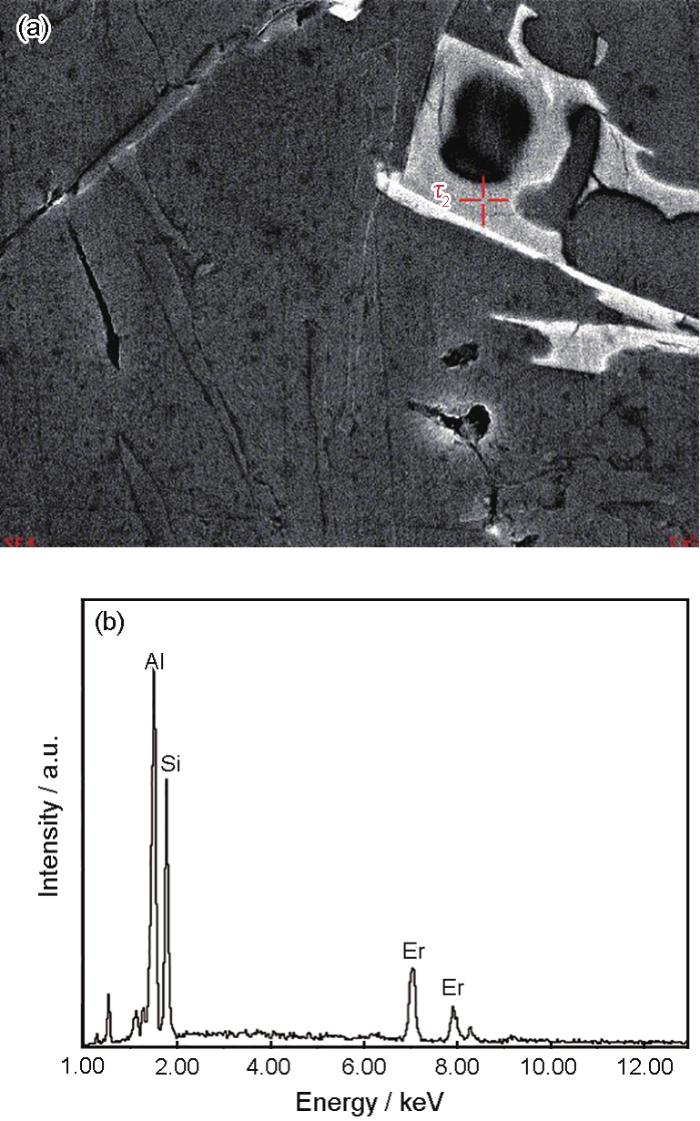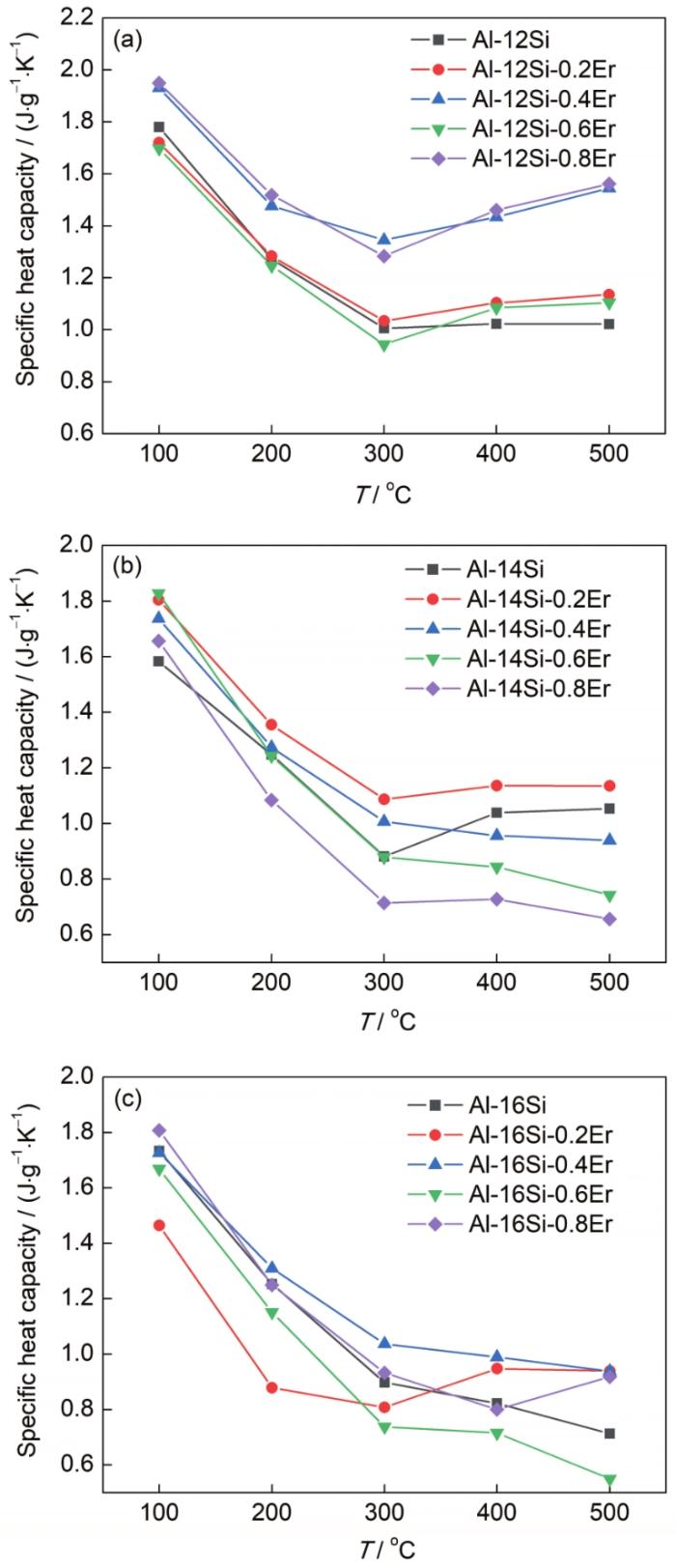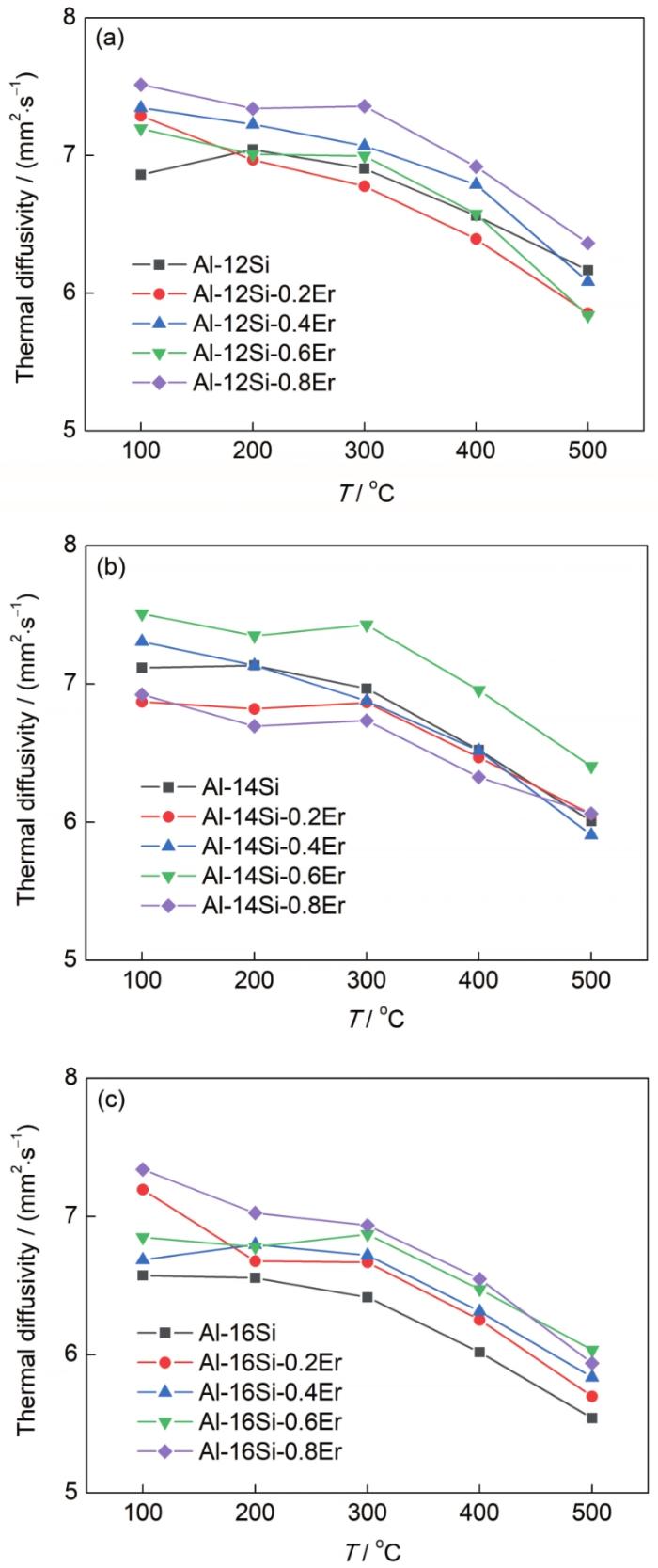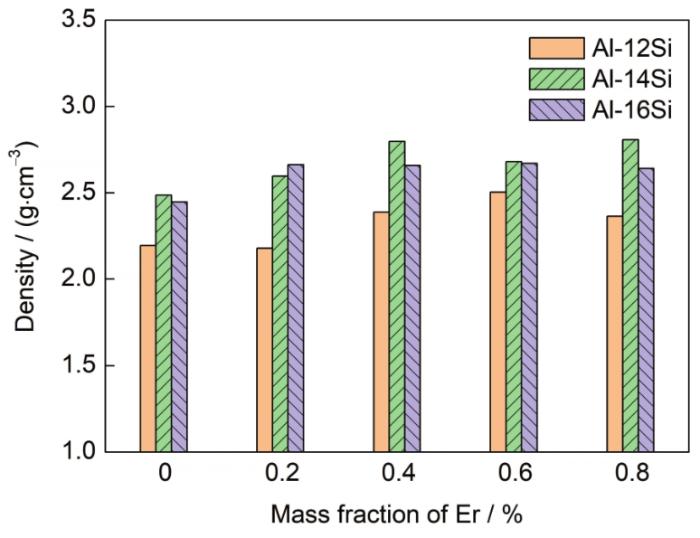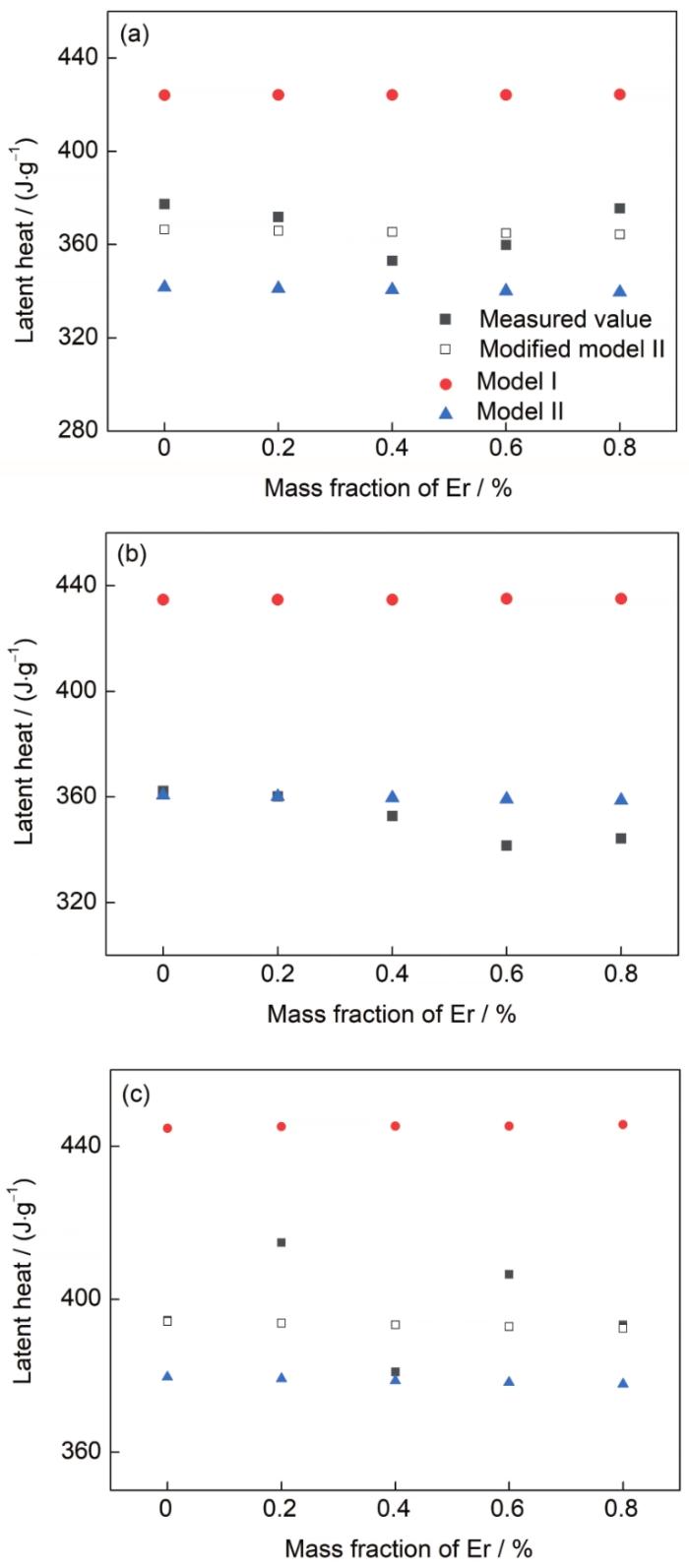随着人类社会的不断发展以及不可再生能源的大量消耗,节能和环保已成为全球关注的话题,新能源的开发利用、提高能源的利用率已成为各国研究的重点。利用储热材料实现热能储存和释放,不断循环进行,就可以解决能量在需求与供应中时间和空间上的不协调,提高能源的利用率,从而达到能源高效利用并节省能源的目的。
1 实验方法
本实验基于熔炼后铸态铝合金进行热物性参数及合金潜热分析。为了能够清晰观察晶界,实验采用Keller试剂腐蚀8 s。利用DM 2700P光学显微镜(OM)和SU8020扫描电子显微镜(SEM)观察组织特征。比热容(cp)通过DSC 404C差示扫描量热仪(DSC)测得,测量温度区间为室温(RT)~550 ℃,升温速率5 ℃/min,测试气氛为Ar气,气体流量为50 mL/min。热扩散系数(α)通过LFA 457激光导热仪(LFA)分析得到,测试气氛为空气,测试温度区间为RT~500 ℃,从100 ℃开始(含),每100 ℃进行一组激光闪射,每组闪射3次测量热扩散系数,取平均值。密度通过GH-128E高精度固体密度仪排水法得到,通过计算得到合金导热系数,通过分析DSC曲线得到合金的相变潜热值。
2 实验结果与分析
2.1 微观组织
图1所示为部分合金组织的OM像。可以看出,未添加Er时(图1a和b),合金组织中同时存在初生α相和初生Si,且初生α枝晶较为发达,可见二次枝晶。添加Er后,初生α枝晶消失,除少量初生Si外,合金几乎为全共晶组织,且初生Si相变小,共晶Si较未添加时粗大(图1c和d)。Er增加至0.4%时(图1e和f),合金中初生Si相进一步减少。可见,Si含量为14%时,Er的添加,可同时抑制初生α和初生Si的析出和长大。图1g和h是Er含量为0.6%、Si含量为14%的组织的OM像。可见,Er的增加和非平衡凝固,改变了合金的组织,使得合金呈现完全共晶组织的特征。图1i和j是Er含量为0.6%、Si含量为16%的组织的OM像,Er含量继续增加,组织中重新出现初生Si,且共晶Si相粗化明显。
图1
图1
Er/Al-Si合金显微组织的OM像
Fig.1
OM images of Al-14Si (a, b), Al-14Si-0.2Er (c, d), Al-14Si-0.4Er (e, f), Al-14Si-0.6Er (g, h) and Al-16Si-0.6Er (i, j)
Al-16Si-0.6Er合金的SEM和EDS分析如图2a和b所示。图2a中α-Al基体上存在一些亮白色中间相,形态一般为棱角分明的条块状,EDS分析结果表明该相由Al、Si、Er 3种元素组成。结合Al-Si-Er三元相图,可以判断该相为τ2相(Er2Al3Si2)。该金属间化合物相结构具有一个充满稀土离子的[Al3Si2]6-晶系,在[Al3Si2]6-框架中,平行Al—Al之字形化学键沿晶格常数b方向的链被Si—Si二聚体桥接,形成垂直于晶格常数a、c平面的Al2Si2层。在Al2Si2层中,由Si和2个Al原子形成的椅状六边形环,沿晶格常数b方向边缘共享。这些层由Al原子连接在一起,通过线性Si—Al—Si键形成三维结构,沿晶格常数b方向的平行隧道,每个隧道中有2排稀土原子[21,22]。
图2
图2
Al-16Si-0.6Er合金的SEM像及EDS结果
Fig.2
SEM image (a) and EDS result (b) of Al-16Si-0.6Er alloy
2.2 导热系数
2.2.1 比热容
图3a~c分别是Si含量为12%、14%、16%时,含0~0.8%Er合金的比热容随温度的变化趋势图。
图3
图3
合金的比热容随温度和Er含量变化曲线
Fig.3
The specific heat capacity of alloy changes with temperature (T) and Er content(a) Al-12Si-xEr (b) Al-14Si-xEr (c) Al-16Si-xEr
2.2.2 热扩散系数
图4
图4
合金的热扩散系数随温度和Er含量变化的折线图
Fig.4
The thermal diffusivity of alloy changes with temperature and Er content(a) Al-12Si-xEr (b) Al-14Si-xEr (c) Al-16Si-xEr
热扩散系数可以表征在相同的温度梯度下传热的速度,金属的热扩散主要通过电子传导,主要受到温度影响。Si含量为12%、16%时,初生α-Al和初生Si相会减弱对电子的散射作用,由于晶界处存在大量的缺陷,Er元素加入对合金组织的细化作用显著,对电子的散射作用增强,也会对热扩散系数产生一定影响。从图4中可以看出热扩散系数随温度升高而下降,Er元素的加入可以改变热扩散系数的大小。
2.2.3 密度
图5是通过排水法测得的各个样品的密度。在不考虑温度对合金密度影响的情况下,可以看出,加入Er元素后合金的密度有所增加。合金Al-14Si-0.4Er和Al-14Si-0.8Er密度最大,均超过了纯Al的密度(2.7 g/cm3)。
图5
合金理论密度根据下式来计算[24]:
式中,ρth为理论密度,ωi为组元i的质量分数,ρi为组元i的密度。
2.2.4 导热系数计算及分析
式中,α为热扩散系数,mm2/s;ρ为密度,g/m3,cp为比热容,J/(g·K)。
图6a~c分别为Si含量为12%、14%、16%,Er含量不同时,合金的导热系数随温度的变化折线图。铝合金导热主要通过2种方式,自由电子和声子。声子作为晶格振动的能量量子,当温度高于该金属Debye温度时,可以忽略声子导热,合金主要通过自由电子导热,电子波受到散射作用时,合金导热能力下降[30,31]。由图6中导热系数随温度的变化趋势可以看出,合金导热系数随温度总体上呈下降趋势。以自由电子传导为主实现导热的合金,如果电子波受到散射,合金导热能力减弱。合金中的空位、晶格畸变、位错使得晶格点阵遭到破坏。Er元素细化晶粒可以增加晶界面积,合金中τ2相(Er2Al3Si2),都可以使电子波受到散射作用,降低电子通过能力。从图6还可以看出,温度低于300 ℃时,电子波散射作用受温度影响很大,合金导热系数随温度升高快速下降;当温度进一步升高,电子波散射作用增加,但因合金中原子振动增强,高于300 ℃时,合金导热系数随温度升高下降减缓。
图6
图6
合金的导热系数随温度和Er含量变化的折线图
Fig.6
The thermal conductivity of the alloy changes with temperature and Er content(a) Al-12Si-xEr (b) Al-14Si-xEr (c) Al-16Si-xEr
2.3 相变潜热分析
2.3.1 相变潜热的测量及理论计算
相变潜热指单位质量的物体在等压恒温条件下,从一个相变化到另一个相所吸收的热量,在DSC曲线上表现为峰的面积。在储热材料的热物特性中,相变潜热决定了材料的储热能力大小。由图7中实际测量合金相变潜热值可知,未添加Er时,Si含量为16%的合金相变潜热最大,Si含量为12%的合金次之,Si含量为14%的合金相变潜热最小;加入Er后,Er含量0.4%和0.6%时,合金相变潜热较低,而在Er含量0.2%和0.8%时,合金的相变潜热较大,但还是低于Al-16Si的相变潜热。Si含量是影响铝基合金相变潜热的主要因素。当Si含量处于12%~14%的范围内时,随着Si含量的增加,合金相变潜热值增加。在Si含量一定时,Er元素的添加对合金的相变潜热值有一定的影响,且合金相变潜热值随着Er元素含量的增加上升。
图7
图7
Al-12Si-xEr、Al-14Si-xEr、Al-16Si-xEr合金的相变潜热实测值与计算值
Fig.7
Measured and calculated values of latent heat of phase transformation of Al-12Si-xEr (a), Al-14Si-xEr (b) and Al-16Si-xEr (c) alloys
其中,Te是多元合金的共晶温度(本工作中用Al-Si合金共晶温度来代替),K;xi是组元i的摩尔分数;ΔSi是组元i的熔化熵,J/(mol·K)。
其中,Ti是组元i的熔点,K;
| Element | Tm | M | ΔS | cp / (J·mol-1·K-1) | |
|---|---|---|---|---|---|
| K | g·mol-1 | J·g-1·K-1 | Solid state | Liquid state | |
| Al | 934 | 27.0 | 0.425 | 25.3 | 29.16 |
| Si | 1685 | 28.1 | 1.061 | 26.0 | 27.20 |
| Er | 1795 | 167.2 | 0.438 | 28.1 | 36.60 |
模型I未考虑共晶物的混合熵以及组元固-液相之间的比热容差对熵的贡献,使得计算结果和实际值差别较大。且该模型是针对严格的共晶体系而言,
结合图1显微组织可知,相对于Al-12Si-xEr、Al-16Si-xEr 2类合金组织,Al-14Si-xEr合金更接近共晶组织,根据共晶合金的非平衡凝固理论,熔点相差较大的合金组元的伪共晶区一般不会呈对称分布,Al-Si合金中两组元熔点相差很大,伪共晶区将偏向高熔点组元Si一侧,因此采用模型II计算得到的Al-14Si-xEr合金相变潜热值和实测值吻合较好,也从侧面说明Al-14Si-xEr更接近合金实际共晶成分。但同时也存在Al-12Si-xEr、Al-16Si-xEr 2类合金计算值和实验值差别较大。分析认为,模型II仅针对共晶成分合金进行理论计算,若将其应用于偏离共晶成分的合金,必然会导致理论计算值与实测值产生较大误差,因此本文考虑对模型II进行修正。考虑到液态合金冷却过程中,从触及液相线即开始释放潜热,因此对于偏离共晶成分的合金,计算时共晶温度Te可采用液相线温度TL进行替换,得到修正模型如下:
对于具有共晶反应的平衡状态二元合金相图,其共晶点两侧的液相线温度可以分别用下式表示:
其中,Tm为纯组元熔点,mL为液相线斜率,CL为溶质成分,Ce为共晶点成分。
为简化计算,其共晶温度以平衡Al-Si合金共晶温度577 ℃代入,纯Al熔点为660.37 ℃,则亚共晶区的液相线温度符合:
纯Si熔点为1414 ℃,过共晶一侧的液相线温度为:
由
2.3.2 方差分析
通过方差分析来考察Si含量和Er含量对相变潜热的影响,以Si含量和Er含量作为自变量,相变潜热作为因变量,进行主效应方差分析,得到的分析结果如表2所示。
表2 相变潜热随Si、Er含量变化方差分析系数表
Table 2
| Source | SS | df | σ | F | Sig. |
|---|---|---|---|---|---|
| Calibration model | 6172.877 | 6 | 1028.813 | 11.141 | 0.002 |
| Intercept | 2082088.817 | 1 | 2082088.817 | 22546.361 | 0.000 |
| Content of Si | 5445.797 | 2 | 2722.899 | 29.486 | 0.000 |
| Content of Er | 727.080 | 4 | 181.770 | 1.968 | 0.193 |
| Error | 738.776 | 8 | 92.347 | ||
| Total | 2089000.470 | 15 |
因素Er含量的检验,检验水平P=0.193>0.05,在显著性水平p=0.05的情况下,无法确定Er含量对材料相变潜热有显著影响。因素Si含量的检验,P=0.002<0.05,因此,在显著性水平p=0.05的条件下,可以认为Si含量对材料相变潜热有显著影响。根据
3 结论
(1) Er加入Al-Si系合金,可以有效改善合金中粗大Si形态,达到细化组织的目的,合金中形成了Er2Al3Si2金属间化合物。
(2) 合金导热系数主要受Si含量、Er含量和温度的影响,合金Al-14Si随Er含量增加,导热系数较未添加Er均有一定程度上升,在Si含量为12%时,Er加入量对导热系数的影响较Si含量为16%时显著。
(3) 模型II计算得到的Al-14Si-xEr合金相变潜热值和实测值吻合较好,以液相线温度替换模型II中的共晶温度进行相变潜热计算,可以推广至非共晶合金场合,修正模型得出的Al-12Si-xEr、Al-16Si-xEr合金相变潜热的理论计算值和实测值更为吻合。
(4) 方差分析Si含量和Er含量对相变潜热的影响结果表明,在显著性水平p=0.05的条件下,可以认为Si含量对合金相变潜热有显著影响,Er对合金相变潜热影响并不显著。
参考文献
Study on properties of Al-Si/Al2O3 composite phase change material for thermal energy storage
[J].
Al-Si/Al2O3高温复合相变蓄热材料的研究
[J].
Integrated modelling and algorithm of material delivery and line-side storage for aircraft moving assembly lines
[J].
Repair bond strength of resin composite to restorative materials after short- and long-term storage
[J].
Preparation and thermal properties of low melting point alloy/expanded graphite composite phase change materials used in solar water storage system
[J].
Phase change material systems for high temperature heat storage
[J].
Research on aluminum component change and phase transformation of TiAl-based alloy in electron beam selective melting process under multiple scan
[J].
Progress in metal-based phase change materials for thermal energy storage applications
[J].
金属基相变材料的研究进展及应用
[J].
Progress in phase change materials and technologies
[J].
相变储热材料及技术的研究进展
[J].
Studies on a heat storage container with phase change material
[J].
Research of thermal storage characteristics of Al-Si alloy as PCM
[J].
金属相变储热材料铝硅合金储热特性研究
[J].
Development of a microencapsulated Al-Si phase change material with high-temperature thermal stability and durability over 3000 cycles
[J].
Effect of compound modification and cooling rate on microstructure and mechanical properties of Al-25%Si alloy
[J].
Effect of rare earth cerium addition on the microstructure and tensile properties of hypereutectic Al-20%Si alloy
[J].
Effects of Er addition on Microstructure and mechanical properties of Al-12Si alloy
[J].
Er添加对Al-12Si铝硅合金组织和力学性能的影响
[J].
Effect of combined RE-Ba-Sb addition on microstructure and mechanical properties of 4004 aluminum alloy
[J].
Effect of rare earth erbium on microstructure and mechanical properties of A356 aluminum alloy
[J]. J
稀土Er对A356铝合金微观组织和力学性能的影响
[J].
Influence of RE on mechanical properties of optimized Al-Si casting alloy
[J].
RE对改良铸造铝硅合金力学性能的影响
[J].
Application and research progress of aluminum-based thermal storage materials in solar thermal power
[J].
铝基合金储热材料在太阳能热发电中的应用及研究进展
[J].
Compositional range, thermal stability, hardness and electrical resistivity of amorphous alloys in Al-Si (or Ge)-transition metal systems
[J].
Ln2Al3Si2 (Ln= Ho, Er, Tm): New silicides from molten aluminum—Determination of the Al/Si distribution with neutron crystallography and metamagnetic transitions
[J].
Study on thermal stability of 2524 aluminum alloy
[J].
The method of reckoning up titanium alloy density form its element contents
[J].
钛合金元素密度法推导计算合金材料密度的研究
[J].
Effect of Fe on the microstructure and the thermal storage performances of high-silicon aluminum alloy
[J].
Preparation and study on the matrix of aluminum potassium sulfate eutectic phase change heat storage materials
[J].
钾明矾基低共熔相变储热材料的制备与研究
[J].
Oxidation resistance and plating encapsulation of Cu-based alloys as phase change materials for high-temperature heat storage
[J].
Development and research progress of high thermal conductivity aluminum alloys
[J].
高导热铝合金的开发与研究进展
[J].
Temperature and composition dependent thermal conductivity model for U-Zr alloys
[J].




